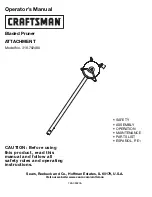
www.scheppach.com
GB | 31
o)
Always use a clamp or a fixture designed to
properly support round material such as rods
or tubing.
Rods have a tendency to roll while be-
ing cut, causing the blade to “bite” and pull the
work with your hand into the blade.
p) Let the blade reach full speed before contact-
ing the workpiece.
This will reduce the risk of the
workpiece being thrown.
q) If the workpiece or blade becomes jammed,
turn the mitre saw off. Wait for all moving
parts to stop and disconnect the plug from the
power source and/or remove the battery pack.
Then work to free the jammed material.
Contin-
ued sawing with a jammed workpiece could cause
loss of control or damage to the mitre saw.
r)
After finishing the cut, release the switch, hold
the saw head down and wait for the blade to
stop before removing the cut-off piece.
Reach-
ing with your hand near the coasting blade is dan-
gerous.
s)
Hold the handle firmly when making an incom
-
plete cut or when releasing the switch before
the saw head is completely in the down posi-
tion.
The braking action of the saw may cause the
saw head to be suddenly pulled downward, caus-
ing a risk of injury.
Safety Instructions for the handling of saw blades
1. Do not use damaged or deformed saw blades.
2. Do not use any insertion tools with cracks. Sort out
cracked insertion tools. Repairs are not permitted.
3. Do not use saw blades made of high speed steel.
4. Check the condition of the saw blades before using
the crosscut, drag and mitre saw.
5. Make sure that a suitable saw blade for the mate-
rial to be cut is selected.
6. Only use saw blades recommended by the man-
ufacturer.
Saw blades designed to cut wood and similar ma-
terials must comply with EN 847-1.
7. Do not use saw blades made of high-speed alloy
steel (HSS steel).
8. Only use saw blades for which the maximum per-
missible speed is not lower than the maximum
spindle speed of the crosscut, drag and mitre saw
and which are suitable for the material to be cut.
9. Observe the saw blade direction of rotation.
g) Inspect your workpiece before cutting. If the
workpiece is bowed or warped, clamp it with
the outside bowed face toward the fence.
Always make certain that there is no gap be-
tween the workpiece, fence and table along
the line of the cut.
Bent or warped workpieces
can twist or shift and may cause binding on the
spinning saw blade while cutting. There should be
no nails or foreign objects in the workpiece.
h) Do not use the saw until the table is clear of all
tools, wood scraps, etc., except for the work-
piece.
Small debris or loose pieces of wood or
other objects that contact the revolving blade can
be thrown with high speed.
i) Cut only one workpiece at a time.
Stacked mul-
tiple workpieces cannot be adequately clamped or
braced and may bind on the blade or shift during
cutting.
j) Ensure the mitre saw is mounted or placed on
a level, firm work surface before use.
A level
and firm work surface reduces the risk of the mitre
saw becoming unstable.
k) Plan your work. Every time you change the
bevel or mitre angle setting, make sure the ad-
justable fence is set correctly to support the
workpiece and will not interfere with the blade
or the guarding system.
Without turning the tool
“ON” and with no workpiece on the table, move
the saw blade through a complete simulated cut
to assure there will be no interference or danger of
cutting the fence.
l) Provide adequate support such as table exten-
sions, saw horses, etc. for a workpiece that is
wider or longer than the table top.
Workpiec-
es longer or wider than the mitre saw table can
tip if not securely supported. If the cut-off piece
or workpiece tips, it can lift the lower guard or be
thrown by the spinning blade.
m) Do not use another person as a substitute for
a table extension or as additional support.
Un-
stable support for the workpiece can cause the
blade to bind or the workpiece to shift during the
cutting operation pulling you and the helper into
the spinning blade.
n)
The cut-off piece must not be jammed or
pressed by any means against the spinning
saw blade.
If confined, i.e. using length stops, the
cut-off piece could get wedged against the blade
and thrown violently.
Summary of Contents for 5901215903
Page 5: ...www scheppach com 5 17 31 6 21 22 17 20 E E E 18 33 19 32 32a 32b 32b...
Page 124: ...www scheppach com 124...
Page 125: ...www scheppach com 125...
Page 126: ...www scheppach com 126...
















































